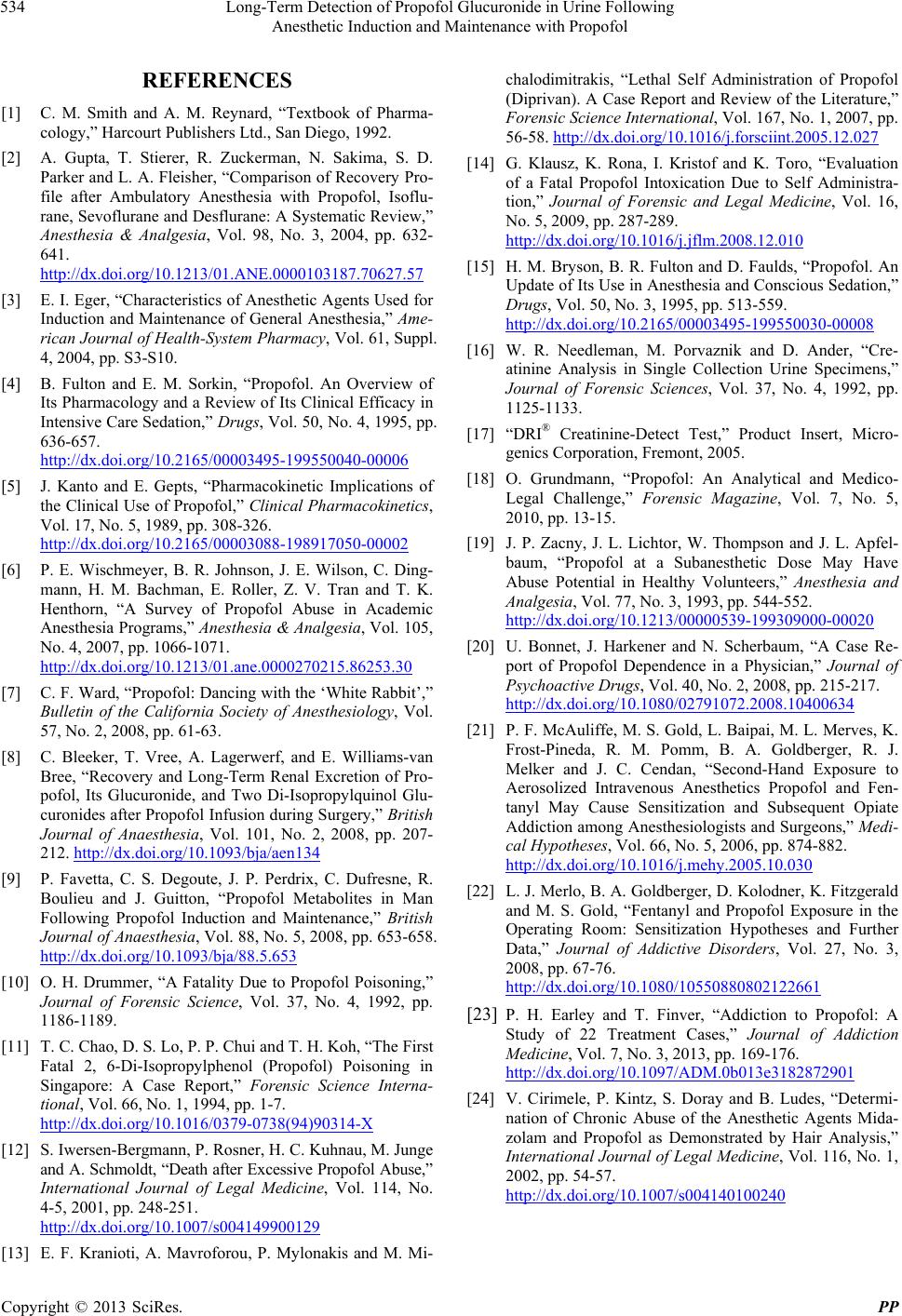
Long-Term Detection of Propofol Glucuronide in Urine Following
Anesthetic Induction and Maintenance with Propofol
Copyright © 2013 SciRes. PP
534
REFERENCES
[1] C. M. Smith and A. M. Reynard, “Textbook of Pharma-
cology,” Harcourt Publishers Ltd., San Diego, 1992.
[2] A. Gupta, T. Stierer, R. Zuckerman, N. Sakima, S. D.
Parker and L. A. Fleisher, “Comparison of Recovery Pro-
file after Ambulatory Anesthesia with Propofol, Isoflu-
rane, Sevoflurane and Desflurane: A Systematic Review,”
Anesthesia & Analgesia, Vol. 98, No. 3, 2004, pp. 632-
641.
http://dx.doi.org/10.1213/01.ANE.0000103187.70627.57
[3] E. I. Eger, “Characteristics of Anesthetic Agents Used for
Induction and Maintenance of General Anesthesia,” Ame-
rican Journal of Health-System Pharmacy, Vol. 61, Suppl.
4, 2004, pp. S3-S10.
[4] B. Fulton and E. M. Sorkin, “Propofol. An Overview of
Its Pharmacology and a Review of Its Clinical Efficacy in
Intensive Care Sedation,” Drugs, Vol. 50, No. 4, 1995, pp.
636-657.
http://dx.doi.org/10.2165/00003495-199550040-00006
[5] J. Kanto and E. Gepts, “Pharmacokinetic Implications of
the Clinical Use of Propofol,” Clinical Pharmacokinetics,
Vol. 17, No. 5, 1989, pp. 308-326.
http://dx.doi.org/10.2165/00003088-198917050-00002
[6] P. E. Wischmeyer, B. R. Johnson, J. E. Wilson, C. Ding-
mann, H. M. Bachman, E. Roller, Z. V. Tran and T. K.
Henthorn, “A Survey of Propofol Abuse in Academic
Anesthesia Programs,” Anesthesia & Analgesia, Vol. 105,
No. 4, 2007, pp. 1066-1071.
http://dx.doi.org/10.1213/01.ane.0000270215.86253.30
[7] C. F. Ward, “Propofol: Dancing with the ‘White Rabbit’,”
Bulletin of the California Society of Anesthesiology, Vol.
57, No. 2, 2008, pp. 61-63.
[8] C. Bleeker, T. Vree, A. Lagerwerf, and E. Williams-van
Bree, “Recovery and Long-Term Renal Excretion of Pro-
pofol, Its Glucuronide, and Two Di-Isopropylquinol Glu-
curonides after Propofol Infusion during Surgery,” British
Journal of Anaesthesia, Vol. 101, No. 2, 2008, pp. 207-
212. http://dx.doi.org/10.1093/bja/aen134
[9] P. Favetta, C. S. Degoute, J. P. Perdrix, C. Dufresne, R.
Boulieu and J. Guitton, “Propofol Metabolites in Man
Following Propofol Induction and Maintenance,” British
Journal of Anaesthesia, Vol. 88, No. 5, 2008, pp. 653-658.
http://dx.doi.org/10.1093/bja/88.5.653
[10] O. H. Drummer, “A Fatality Due to Propofol Poisoning,”
Journal of Forensic Science, Vol. 37, No. 4, 1992, pp.
1186-1189.
[11] T. C. Chao, D. S. Lo, P. P. Chui and T. H. Koh, “The First
Fatal 2, 6-Di-Isopropylphenol (Propofol) Poisoning in
Singapore: A Case Report,” Forensic Science Interna-
tional, Vol. 66, No. 1, 1994, pp. 1-7.
http://dx.doi.org/10.1016/0379-0738(94)90314-X
[12] S. Iwersen-Bergmann, P. Rosner, H. C. Kuhnau, M. Junge
and A. Schmoldt, “Death after Excessive Propofol Abuse,”
International Journal of Legal Medicine, Vol. 114, No.
4-5, 2001, pp. 248-251.
http://dx.doi.org/10.1007/s004149900129
[13] E. F. Kranioti, A. Mavroforou, P. Mylonakis and M. Mi-
chalodimitrakis, “Lethal Self Administration of Propofol
(Diprivan). A Case Report and Review of the Literature,”
Forensic Science International, Vol. 167, No. 1, 2007, pp.
56-58. http://dx.doi.org/10.1016/j.forsciint.2005.12.027
[14] G. Klausz, K. Rona, I. Kristof and K. Toro, “Evaluation
of a Fatal Propofol Intoxication Due to Self Administra-
tion,” Journal of Forensic and Legal Medicine, Vol. 16,
No. 5, 2009, pp. 287-289.
http://dx.doi.org/10.1016/j.jflm.2008.12.010
[15] H. M. Bryson, B. R. Fulton and D. Faulds, “Propofol. An
Update of Its Use in Anesthesia and Conscious Sedation,”
Drugs, Vol. 50, No. 3, 1995, pp. 513-559.
http://dx.doi.org/10.2165/00003495-199550030-00008
[16] W. R. Needleman, M. Porvaznik and D. Ander, “Cre-
atinine Analysis in Single Collection Urine Specimens,”
Journal of Forensic Sciences, Vol. 37, No. 4, 1992, pp.
1125-1133.
[17] “DRI® Creatinine-Detect Test,” Product Insert, Micro-
genics Corporation, Fremont, 2005.
[18] O. Grundmann, “Propofol: An Analytical and Medico-
Legal Challenge,” Forensic Magazine, Vol. 7, No. 5,
2010, pp. 13-15.
[19] J. P. Zacny, J. L. Lichtor, W. Thompson and J. L. Apfel-
baum, “Propofol at a Subanesthetic Dose May Have
Abuse Potential in Healthy Volunteers,” Anesthesia and
Analgesia, Vol. 77, No. 3, 1993, pp. 544-552.
http://dx.doi.org/10.1213/00000539-199309000-00020
[20] U. Bonnet, J. Harkener and N. Scherbaum, “A Case Re-
port of Propofol Dependence in a Physician,” Journal of
Psychoactive Drugs, Vol. 40, No. 2, 2008, pp. 215-217.
http://dx.doi.org/10.1080/02791072.2008.10400634
[21] P. F. McAuliffe, M. S. Gold, L. Baipai, M. L. Merves, K.
Frost-Pineda, R. M. Pomm, B. A. Goldberger, R. J.
Melker and J. C. Cendan, “Second-Hand Exposure to
Aerosolized Intravenous Anesthetics Propofol and Fen-
tanyl May Cause Sensitization and Subsequent Opiate
Addiction among Anesthesiologists and Surgeons,” Medi-
cal Hypotheses, Vol. 66, No. 5, 2006, pp. 874-882.
http://dx.doi.org/10.1016/j.mehy.2005.10.030
[22] L. J. Merlo, B. A. Goldberger, D. Kolodner, K. Fitzgerald
and M. S. Gold, “Fentanyl and Propofol Exposure in the
Operating Room: Sensitization Hypotheses and Further
Data,” Journal of Addictive Disorders, Vol. 27, No. 3,
2008, pp. 67-76.
http://dx.doi.org/10.1080/10550880802122661
[23] P. H. Earley and T. Finver, “Addiction to Propofol: A
Study of 22 Treatment Cases,” Journal of Addiction
Medicine, Vol. 7, No. 3, 2013, pp. 169-176.
http://dx.doi.org/10.1097/ADM.0b013e3182872901
[24] V. Cirimele, P. Kintz, S. Doray and B. Ludes, “Determi-
nation of Chronic Abuse of the Anesthetic Agents Mida-
zolam and Propofol as Demonstrated by Hair Analysis,”
International Journal of Legal Medicine, Vol. 116, No. 1,
2002, pp. 54-57.
http://dx.doi.org/10.1007/s004140100240